| Author |
Message |
Blaz Berlec

|
 Posted: Mon 05 Apr, 2004 2:13 pm Post subject: 14. - 15. century longsword suspension system Posted: Mon 05 Apr, 2004 2:13 pm Post subject: 14. - 15. century longsword suspension system |
 |
|
Hi folks!
I'm planning to make a scabbard for my sword. It's a cheap Czech reenactment rebated XIIa, which I have reshaped recently (extended fuller to cross, removed ricasso, etc). Since the cross doesn’t have écusson, scabbard will be similar to that of Albion’s Tritonia or Gaddhjalt. The only thing changed would be the type of suspension.
Although laced leather suspension looks really great, it’s a bit complicated for me, and it’s just a bit off period for my reenactment group, which is set at the end of 14. century. So I’m looking for alternatives. Does anyone have any information on 14. and 15. century belts and sword suspensions? I can’t seem to find anything useful in books and homepages…
And another question: would the “laced” leather suspension or a similar one even work for the one and a half handed longsword? I have the impression that long sword should be suspended with a bit more of an angle, so you don’t trip over it all of the time. Or maybe I’m just clumsy. Or should I rather get a horse to hang my sword on? 
Thank you for your replies!
Blaz
 Attachment: 10.98 KB Attachment: 10.98 KB

My sword in it's original shape.
 Attachment: 12.39 KB Attachment: 12.39 KB
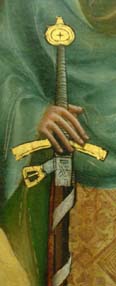
Basic idea for belt / attachment. Tis is from Albion's Landgraf.
Extant 15th Century German Gothic Armour
Extant 15th century Milanese armour
Arming doublet of the 15th century
|
|
   |
 |
Blaz Berlec

|
 Posted: Tue 04 May, 2004 1:10 pm Post subject: Posted: Tue 04 May, 2004 1:10 pm Post subject: |
 |
|
OK, this is roughly what I'm looking for. Simple suspension and scabbard. Anyone has any pictures from surviving objects or artwork?
Picture is from Czech St. Patrick's Workshop (Lobko) [url]http://www.swordcutler.com/index_en.php [/url], maker of relatively cheap and really good reenactment swords (longswords weigh 1.5 - 2 kg).[/url]
 Attachment: 15.3 KB Attachment: 15.3 KB

Suspension from beginning of 14. century
Extant 15th Century German Gothic Armour
Extant 15th century Milanese armour
Arming doublet of the 15th century
|
|
   |
 |
Blaz Berlec

|
|
   |
 |
Nathan Robinson
myArmoury Admin


|
|
    |
 |
Blaz Berlec

|
 Posted: Tue 05 Oct, 2004 10:21 am Post subject: 14th century scabbard and belt? (pics) Posted: Tue 05 Oct, 2004 10:21 am Post subject: 14th century scabbard and belt? (pics) |
 |
|
OK, Nathan, thank you for your permission. So here it is, in it's entirety and boredom. 
Greetings all!
I hope this is the right place to post my question, and that I'm not exaggerating with images. I’m currently making plans for scabbard and belt (and of course suspension system) for my one and a half handed sword (picture of it is below). My re-enactment costume is in the making, and should portray man-at-arms (or poor knight) somewhere in the mid-14.th century. I would like it to be as historically correct as possible.
I went through all available literature and web-sites and still haven’t decided on the shape of belt and type of suspension. The obvious choice would of course be the plaque belt, somehow attached to the scabbard locket. I know of no modern reproduction of a complete set of belt and suspension. Here’s a small picture of effigy wit such arrangement:

Sir Roger de Kerdeston (d.1337)
But I have some problems with that – plaque belt making is far beyond my skill (for now), and I’m trying to portray more simple and “cheap” equipment – with plaque belt I would also need other knightly equipment like full (or almost full) plate harness…
The second option is presented in detail in Oakeshott’s Archeology of Weapons – plate 17, text on pages 304 – 307. There are (usually) two lockets on a scabbard, lower with one ring and upper one with two rings. Right side of belt (the part with the buckle) is attached to a ring on upper locket, and on the left side there are two belt ends, each connected to the ring on locket, and they soon join to form a left part of belt which goes around one’s body. Sometimes there’s only one left part of belt and a single (upper) locket with two rings. This type was used around 1320 – 1340, I think. I don’t think I’ve seen a modern reproduction of such suspension, apart form some LOTR fantasy pieces. I have yet to see good picture of this type, here are few small ones:

Sir William Ryther (d.1308)

Aymer de Valence (d.1324)

Sir John de Creke c.1325
The third type is of course old all-leather belt and suspension system, but that would be fairly outdated in 1350, at least for knights - I don’t know about men at arms… That one is I think best represented in modern reproduction (by Albion Armorers and various others) and best documented – there are diagrams in many books, and a very good one by Peter Johnsson was posted here on SFI.

Handmade scabbard by Kevin Iseli, in a style popular from the late 12th C to mid 13th C. (Albion Armorers)
So right now I'm completely undecided and without ideas. But I'm liking the method with lockets and rings best.
I have some skill at metal forming and welding, so buckles, terminals, lockets and chapes should not be too much problem. Wooden part of scabbard is also easy part. I have very little skill in leather forming and belt making, but I’ll have some help with this.
My costume will also include a simple unvisored bascinet with long padded mail aventail (made, currently on a way here), a gambeson (not yet made), mitten gauntlets (have) and a surcoat.
So, what are your suggestions? Do you have any book recommendations, links or images that would help me? Do you know of any maker of above mentioned things (apart from all leather suspension)? I would appreciate any idea or thought.
Thank you for your replies! I'll certainly post images of whatever will be created.
Blaz Berlec
 Attachment: 52.05 KB Attachment: 52.05 KB

Oh, and here's a picture of my sword. It's nothing special, fairly light (1,7 kg) one and a half handed blunt reenactment Czech thing, which I reshaped quite a bit, and recently added replica coins in recesses. I know the shape of blade (XIIa), pommel and
Extant 15th Century German Gothic Armour
Extant 15th century Milanese armour
Arming doublet of the 15th century
|
|
   |
 |
Chad Arnow
myArmoury Team


|
|
    |
 |
Blaz Berlec

|
|
   |
 |
Chad Arnow
myArmoury Team


|
 Posted: Tue 05 Oct, 2004 10:41 am Post subject: Posted: Tue 05 Oct, 2004 10:41 am Post subject: |
 |
|
| Blaz Berlec wrote: | | Thank you very much. I've searched net thorougly and found some companies that make plaque belts (all at outrageous prices in my opinion) - even these two, but I haven't found any page that has any information about form of scabbard attachment to that belt. Interesting, I must say. |
There is a great picture in Oakeshott's Archeology of Weapons showing a belt suspension for a scabbard (Plate 13a). The scabbard would have had a ring attached to it. One of the plaques on the belt had two plaques hanging beneath it; each plaque is smaller than the one above. The bottom one has a hook on it. The ring on the scabbard would fit over this hook.
If I had a better scanner, I'd post the pic.

ChadA
http://chadarnow.com/
|
|
    |
 |
Blaz Berlec

|
 Posted: Tue 05 Oct, 2004 10:46 am Post subject: Posted: Tue 05 Oct, 2004 10:46 am Post subject: |
 |
|

No need, I have the book. I just haven't seen such suspension on effigies or brasses - swords there hang like directly attachet to belt, not suspended on a hanger several inches below the belt. But then again, almost all effigies show swords nearly vertical. That would hide any hanger behind the scabbard. But the hanger should then be attached on the ring behind the scabbard, not on the side!?
Extant 15th Century German Gothic Armour
Extant 15th century Milanese armour
Arming doublet of the 15th century
|
|
   |
 |
|
Michael P Smith
|
 Posted: Tue 05 Oct, 2004 7:53 pm Post subject: Posted: Tue 05 Oct, 2004 7:53 pm Post subject: |
 |
|
If I may cross post form another board (not SFI):
Some more info:
On the 14th century suspensions that look like 15th century. Oakeshott says that this style is most popular from c. 1310-1340, and after 1380. He has a drawing of the sword and scabbard fitting you mention. BUT, he also has a photo (plate 46 in Sowrd in the Age of Chivalry) of a sword (thought to be type XIIIb with the a very similar arrangment. It was found in a tomb dated at 1329. I'd say the practice is pretty securly dated to the early-mid 14th century.
On the style that looks like the scabbard is glued to the hip belt. A friend of mine is a medieval scholar and is doing some research on 14th century military dress accessories. He says he has personally seen a couple surviving "hooks" that are reputed to be hangers from this period. The idea being that the hook is attached to the belt and a ring is on the back of the scabbard. Or the other way around. He has some interesting observations and theories on these hooks. They first appear when hand and half sword start becoming the dominant weapon of the knightly class. When they first appear, they are mostly seen in conjuction with hand and ahalf swords, while most contemporary arming swords still use the ring suspension style (usually a two ring style on a single locket). Later, most all swords use this style in conjunction with the hip belt. His theory is that the hook and ring method would allow the quick and easy removal of the scabbard from the belt when either a) transferring it to the saddle, or b) going into battle. In this way, the knight could still show off his fancy (and expensive) plaque belt without the interference of the large scabbard, though when this tecnique first appears, most belts are still worn a bit higher and aren't "hip belts" proper.
Dunno... but it seems like a decent theory. He promises to clue me in when he finishes his research and writes a paper.
Mike
Albion's website has a page on custom scabbard that includes some early-mid 14th century locket/ring suspension.
|
|
  |
 |
|
Felix Wang
|
 Posted: Tue 05 Oct, 2004 8:00 pm Post subject: Posted: Tue 05 Oct, 2004 8:00 pm Post subject: |
 |
|
Albrecht Duerer, 1513: Knight, Death and the Devil shows a suspension very much like the very first one posted on this thread (back in the Spring). The first, shorter strap to the belt is hidden by an arm, but the second longer strap is clearly seen, as is the position of the belt.
http://www.abcgallery.com/D/durer/durer1.html
|
|
  |
 |
Blaz Berlec

|
 Posted: Wed 06 Oct, 2004 9:22 am Post subject: Posted: Wed 06 Oct, 2004 9:22 am Post subject: |
 |
|
Hi all!
Thanks for your replies.
I think plaque belt is out of the question for me. I don’t know a thing about it (as I found out). How is it attached to the wearer? They are usually WAAAY too low to be just strapped around and stayed there, let alone carried weight of a 3 pound (1,5 kg) sword. And this hook-and-ring attachment – it must be secured in some way, otherwise the scabbard would fall off the hook at every little bounce (and mounted knights usually do bounce). Not to mention the instability of such attachment through single ring – it hangs completely vertically and you have absolutely no control of it, so it’s swinging wildly at every step… Been there, done that (tripped over my own sword, usually with hands full of food or drink). And about detaching scabbard each time you dismount – this seems silly to me. What if you don’t plan to use your sword right away, and have other weapon in hands – do you leave your sword on a horse then? And when you need it, you go and fetch it? A lot of fighting in 14th century went on foot, and knights often dismounted to fight.
There are some nice images in Oakeshotts “Records of Medieval Sword” (re-read it yesterday) – XIIIb.1 is from before 1319, and has a really nice version of 3 ring “locket hangers” suspension system. There is also XII. 19 with 2 rings from 1320 – 50, and of course XV.6, where Oakeshott wrote, that this type of suspension was fashionable from 1320 – 1340, but not before and after.


These two scabbards by Kevin Iseli (Albion Armorers) look like the ring suspension system from 14.th century, but somehow the very narrow belts indicate to me a bit later date. And the left two belts joining at ring also looks later to me. Anyway, they are very good representations of what I want.
Peter Johnsson, posted 12-27-2002 on NetSword forum:
During the 14th C metal mounts at the top of the scabbard came into use. Sometimes just one, some times two. To these were rings attatched that connected to the belts. One or two belt sections backwards one toward the front.¨
The scabbard on the sword of Can Grande Della Scala is a good example. This sword is dated to the early 14th C.
Later on when swords of type XVII (good for thrusting) became popular a carrying method for fully armored men-at-arms was to carry the sword hanging perpendicular in a short strap around the waist belt and a little horisontal loop fixed to the mounting at the top of the scabbard.
Older scabbards vere still used by less well-to-do. In a print by Dürer from the early 16th C a peasant is shown wearing a sword of typical 13th C stype wih original scabbard. The point of the sword has eaten through the scabbard.
What is approprtiate to wear at any time depends on which type of sword s worn, wether the wearer is militatry or semi-civilian (armour will be a deciding factor) and social status (how wealthy and infuential the person is).
To feign continued use of older styles would be approporate for those that cannot afford or otherwise get that which is of latest style. Looking at artwork it seems that most kept themselves pretty much up to the latest style, though.
Some other nice images of suspension I found:
http://www.sweb.cz/armadefensiva/

One handed sword, Arma Defensiva (Czech Republic)

One and a half handed sword, Arma Defensiva (Czech Republic)
Keep it coming, this is interesting!
 Attachment: 46.88 KB Attachment: 46.88 KB
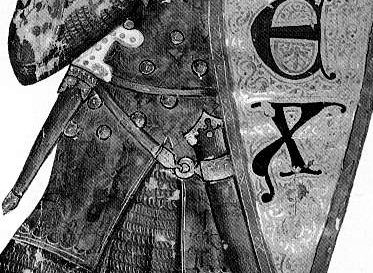
early 14.th century suspension
 Attachment: 14.77 KB Attachment: 14.77 KB
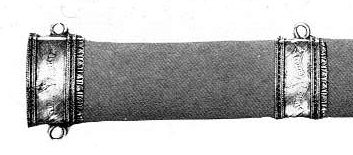
Records of Medieval Sword, XV.6
Extant 15th Century German Gothic Armour
Extant 15th century Milanese armour
Arming doublet of the 15th century
|
|
   |
 |
|
Michael P Smith
|
 Posted: Wed 06 Oct, 2004 11:24 am Post subject: Posted: Wed 06 Oct, 2004 11:24 am Post subject: |
 |
|
Here's a couple more pics from The Sword in the Age of Chivalry
First: a three ring suspension from about 1329. Not that the top two rings are slightly offset. A single locket with offset rings would hold the sword at a convenient angle.
Second: a sword and scabbard from before 1319. Oakeshott remarks that the belt fittings have been incorrectly reattached to a single locket ring instead on one on each ring
Mike
 Attachment: 27.11 KB Attachment: 27.11 KB
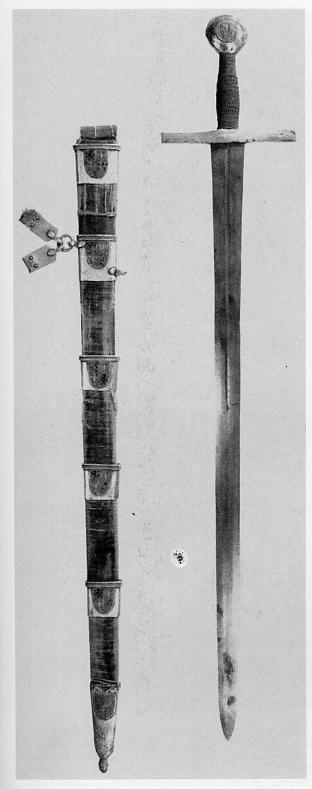
 Attachment: 15.48 KB Attachment: 15.48 KB

|
|
  |
 |
|
Douglas G.
|
 Posted: Thu 07 Oct, 2004 11:46 pm Post subject: Posted: Thu 07 Oct, 2004 11:46 pm Post subject: |
 |
|
Blaz,
For what it's worth, that is my A&A 12th century in the black scabbard
made for it by Kevin at Albion. I have to hold the hilt when I wear it if I want
to walk anywhere without the sword either pommel in my armpit or chape
dragging on the ground. My opinnion? Either the men were taller than we
thought back then or better working with just one free hand.
Doug G.
|
|
  |
 |
Blaz Berlec

|
 Posted: Mon 11 Oct, 2004 10:54 am Post subject: Posted: Mon 11 Oct, 2004 10:54 am Post subject: |
 |
|
| Douglas G. wrote: | Blaz,
For what it's worth, that is my A&A 12th century in the black scabbard
made for it by Kevin at Albion. I have to hold the hilt when I wear it if I want
to walk anywhere without the sword either pommel in my armpit or chape
dragging on the ground. My opinnion? Either the men were taller than we
thought back then or better working with just one free hand.
Doug G. |
Doug, A&A is only 43.3" or 110 cm long! I have carried 45 and 48" long swords in a simple leather "half-scabbard" and I never had any problems with the size of the swords - they never bothered my armpit or dragged on ground (except at descending stairs or on very rough terrain) – I only have problem with them swinging between my legs when I’m walking. Maybe your scabbard is hanging too vertically - you could shorten your lower left strap (from the image it seems it is adjustable) so your sword will hang with a bit more of an angle. Effigies and brasses usually don’t show that (well, the artists back then didn’t bother with perspective that much), but some medieval artworks show that the swords hung from the belt at quite large angle – up to 45 degrees. I’m attaching some of them below.
Oh, and your scabbard looks great. I don’t think anymore that it looks “non-14th century” – although most effigies I’ve seen show much wider belts and belt terminals, are almost all surviving 14th century belt terminals as narrow as yours (see images above).
My project is slowly progressing, although I still haven’t decided on most details.
 Attachment: 18.7 KB Attachment: 18.7 KB
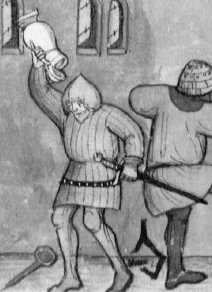
Medieval man at arms, holding his sword - seems he had problems with it too.
 Attachment: 14.71 KB Attachment: 14.71 KB
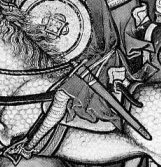
 Attachment: 11.15 KB Attachment: 11.15 KB
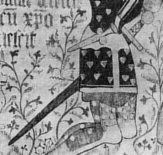
 Attachment: 26.93 KB Attachment: 26.93 KB
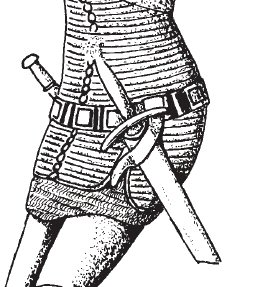
 Attachment: 40.67 KB Attachment: 40.67 KB
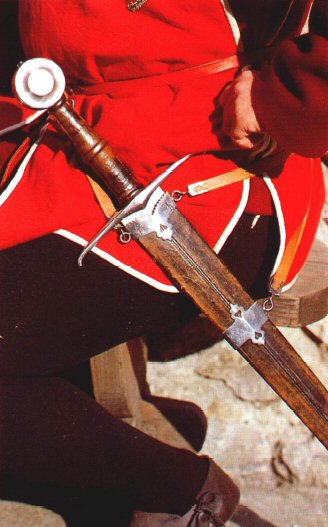
Some more images of reproductions
 Attachment: 10.73 KB Attachment: 10.73 KB
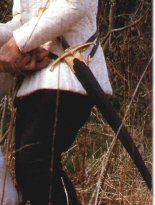
Extant 15th Century German Gothic Armour
Extant 15th century Milanese armour
Arming doublet of the 15th century
|
|
   |
 |
Blaz Berlec

|
|
   |
 |
Blaz Berlec

|
 Posted: Mon 18 Oct, 2004 11:04 am Post subject: Posted: Mon 18 Oct, 2004 11:04 am Post subject: |
 |
|
Hello all who haven't abandoned all hope in this topic!
My quest for historically accurate 14th century scabbard and belt continues. I still have several unknown areas. The thing that troubles me the most is the part that is usually hidden on effigies – the conjunction of left two belts from lockets into one belt that goes around the body.
I kindly asked Kevin Iseli of Albion Armorers about this problem, and pointed to his designs which are already posted on this topic above. There the left two belts converge through the ring. Here is his answer – (I hope I’m not doing something terribly wrong by posting it here, I believe it is interesting to many readers):
“The ring attachment was not as common as a hook and buckle suspension that would attach the 2 left belts the back of the waist belt. The buckle is simply 2 side by side vertical ovals with a small loop below them to hold the hook. The waist belt would pass through both ovals so that this type of buckle could side left or right on the waist belt. This gives you the ability to raise or lower the tip of your scabbard by just sliding this one buckle closer or further from your hip. A sample of this suspension just got posted on Albions website as the Regent scabbard. This scabbard is more 15th century, but if you replaced the scabbard knots with a metal throat and central locket to which to 2 left belts attach, you will have something that would be very close to 14th C. man-at-arms scabbard.”
Here is the Regent scabbard and its left side of suspension so you can better imagine how the described system works.

I looked again through all available images of this type of suspension, and I believe it must have been a bit different. 14. C. belt is different than 15. C. Regent one – it does not have “separate” waist belt, to which two short left straps would attach. Narrow waist belts on some 14. C. effigies are separate belts for carrying daggers or just for decoration.
I think that left side of belt could have been just split in two straps, not unlike on all-leather suspension of previous centuries. Or it could have been similar to Regent suspension, but without the waist belt. I have made a simple sketch which shows this idea. It’s ugly, but I hope it’s understandable.
So, tell me what you think! Any comments, ideas?
Blaz
 Attachment: 8.52 KB Attachment: 8.52 KB
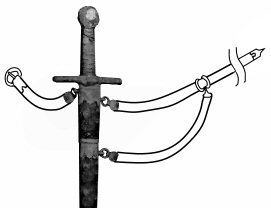
My idea of 14th century suspension system - note the attachment of left lower strap to movable buckle.
 Attachment: 87.3 KB Attachment: 87.3 KB
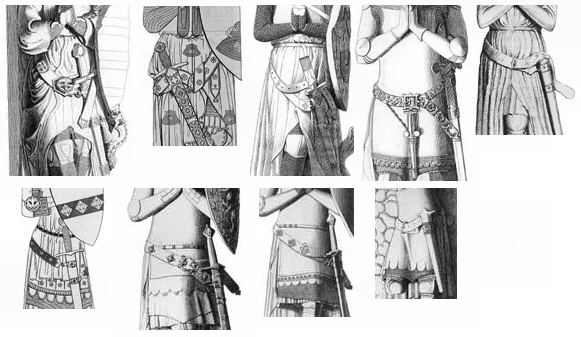
Some 14th century samples of suspension systems.
 Attachment: 17.74 KB Attachment: 17.74 KB

The only side view of 14th century effigy I could find. Unfortunately the suspension is with only one left belt.
Extant 15th Century German Gothic Armour
Extant 15th century Milanese armour
Arming doublet of the 15th century
|
|
   |
 |
|
Michael P Smith
|
 Posted: Mon 18 Oct, 2004 2:45 pm Post subject: Posted: Mon 18 Oct, 2004 2:45 pm Post subject: |
 |
|
I think you're first illustration is most likely based on my research. Mind if I steal it? Kevin is going to make me a scabbard for my NextGen Prince, and I'd like to look like that. 
Mike
|
|
  |
 |
Blaz Berlec

|
 Posted: Mon 18 Oct, 2004 3:07 pm Post subject: Posted: Mon 18 Oct, 2004 3:07 pm Post subject: |
 |
|
Go right ahead, Michael.
And by the way, I have "Records of Medieval Sword" and "Archaeology of Weapons" by Oakeshott, and both books have this photo - it's the sword of Can Grande Della Scala (d. 1329). I have referenced it in one of above posts (Archaeology..., Plate 17). But yes, I have used your image, since I don't have a scanner. Which is a pity, because I'm really bad at drawing sketches on computer.
That sketch is only an idea, and it could be completely wrong - I mean not historically correct. I'd still trust Kevin's research. Maybe he had this kind of suspension in mind when he described it to me in a letter, posted above, but simplified it a bit.
Extant 15th Century German Gothic Armour
Extant 15th century Milanese armour
Arming doublet of the 15th century
|
|
   |
 |
|
Kevin Iseli
Industry Professional
Location: New Glarus, WI Joined: 21 Sep 2003
Posts: 32
|
 Posted: Tue 19 Oct, 2004 12:57 pm Post subject: Posted: Tue 19 Oct, 2004 12:57 pm Post subject: |
 |
|
Blaz,
I think that the idea in your sketch is a plausible and eligant solution. I'm still trying to steal a few minutes with Peter J. to talk scabbards, but we run him ragged while he's here!  At any rate, I think you are definately headed in the right direction. Sorry that I don't have more time to research and post, but I'm currently battling with some 15th century solutions of my own. At any rate, I think you are definately headed in the right direction. Sorry that I don't have more time to research and post, but I'm currently battling with some 15th century solutions of my own. 
Thanks to everyone who posted all of the excellent pictures by the way! I shall have to study much of this thread when I get a chance.
Cheers,
--Kevin Iseli
Elvenarts scabbard shop
|
|
  |
 |
|
|
You cannot post new topics in this forum
You cannot reply to topics in this forum
You cannot edit your posts in this forum
You cannot delete your posts in this forum
You cannot vote in polls in this forum
You cannot attach files in this forum
You can download files in this forum
|
All contents © Copyright 2003-2024 myArmoury.com — All rights reserved
Discussion forums powered by phpBB © The phpBB Group
Switch to the Basic Low-bandwidth Version of the forum
|

